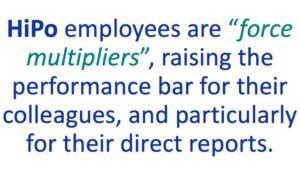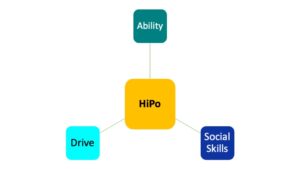
A High-Potential employee (HiPo) is someone who possesses the required skills, motivation, and potential to move up to and succeed in senior leadership positions.
HiPo employees usually stand out from their colleagues by demonstrating leadership skills, technical expertise, high productivity, and the potential to improve individual and organizational performance.

High potential vs. high performing
It’s essential to know the differences between HiPos and high performers. HiPos are generally high performers, but not all high performers are HiPos. A high performer who does well in their current role does not necessarily have the potential to climb up the career ladder to more critical leadership roles. High-performance employees may have a specific set of skills that are beneficial to their performance and your organization’s growth, but not the potential to lead at the highest levels. They may also lack the motivation or desire to advance their careers in an upward direction, which separates them from HiPos.
Scientific studies on what predicts job performance with the most needed qualities for the 21st century workforce, found three general signs of High-Potential.

Ability
The first sign is showing that an individual can do the job in question. The best way to measure this is by observing the candidate doing the key tasks that make up the job. This is called a work sample test and it is the best predictor of job performance. But to predict potential for a bigger, more complex job in the future, we need to know how likely an individual is to learn and master new knowledge and skill. The best predictor of this is IQ or cognitive ability. Learning ability also involves motivation to acquire new knowledge and skills quickly and flexibly. Different roles require different abilities beyond cognitive ability. For example, potential for a leadership role at the executive level requires strategic thinking and the ability to adapt an organization for the long-term future. This also requires vision and imagination, as well as an entrepreneurial mindset. So early signs of the ability for senior organizational leadership would also include creativity and a talent for systems thinking.
Social skills
The second sign reflects the importance of team work and collaboration in modern organizations. At a basic level, employees have to be able to get along and earn the support of supervisors and coworkers. In fact, the main reason for managerial failure is relationships problems. Social skills involve two basic abilities: the ability to manage yourself and the ability to manage others (relationships). Employees who are likely to succeed in bigger, more complex jobs are first able to manage themselves — to cope with increased pressure, deal positively with adversity, and act with dignity and integrity. Secondly, they are able to create and maintain cooperative working relationships, build a wide network of contacts and form alliances, and be influential and persuasive with different stakeholders. And for senior roles, they have to be able to develop advanced political skills — the ability to read an audience, decode the hidden rules, and find solutions that satisfy the often conflicting interests of key power brokers. The ability to manage oneself and to manage others are the core elements of emotional intelligence. So an early sign of high potential is emotional intelligence, which can be tested by psychometric tests and improved through training and development.
Drive
The third sign is having the desire and motivation to work hard, achieve, and do whatever is necessary to get the job done. It is easily seen as work ethic and ambition — an ability to remain dissatisfied with one’s achievements. This motivational sign is the accelerator that increases the potential impact of ability and social skills on future success. Ability and social skill may be seen as talent; but potential is talent multiplied by drive as this will determine how much ability and social skills are used. Drive can be measured by standardized tests that assess conscientiousness, achievement motivation, and ambition. It can also be observed behaviorally — as shown by how hard an individual works, willingness to take on extra duties and assignments, eagerness for more responsibility, and even readiness to sacrifice. For example, many executive-level roles require a global mindset and some cross-cultural experience. The willingness to accept some psychological and even physical discomfort and relocate in order to gain the experience and develop these skills separates talented individuals from true high potentials. In conclusion, most organizations could probably improve their talent identification processes if they keep things simple and focus on these three generic signs of potential. Not many employees are highly able, socially skilled, and driven — but if you bet on those who are, which involves evaluating these qualities as accurately as you can, you will end up with a higher proportion of future stars who will contribute disproportionately to the organization. Investing in those individuals will produce the highest ROI.